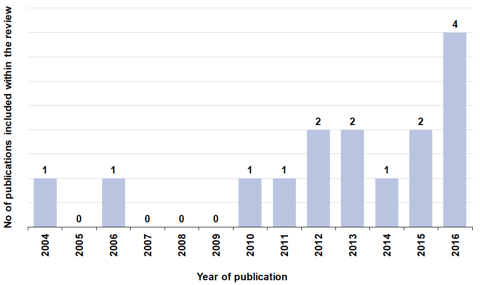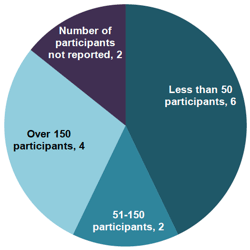Young people's experience of education and training
Report on young people's experience of their learner journey from the age of 15-24 years.
2. Review of existing evidence
Chapter summary
- A desk review of existing evidence relating to post-15 learner journeys in Scotland was carried out.
- A total of 15 documents were included within the review, most of which involved primary research with young people on their experiences of the Scottish education, skills and learning system.
- Most of the studies were small scale and qualitative in nature, focussing on one particular geography or cohort of learners.
- A gap was identified in terms of larger-scale studies that consider the experiences of all learners within the Scottish education and learning system.
- The key messages from the existing evidence are that:
- Young people's decisions about career pathways are not taken in isolation from wider social and cultural considerations.
- There is a need for better integration of the various elements of the 'system' and for learners to receive appropriate advice and support at the right time in their journeys to enable them to navigate this.
- Young people with additional support needs, or who are facing other barriers to progression, require intensive and tailored support in order to make successful transitions.
Introduction
2.1 A key aim for the study was that it moved beyond what was already known about the issues and challenges within the post-15 learner journey in Scotland to generate new insights and resultant policy and system implications. To this end, a desk review of existing data, evidence and research on the learner journey was carried out and this chapter reports on the headline messages from this. It begins with an overview of the approach taken to the review, followed by a summary of the key messages arising from this.
Approach
2.2 A total of 15 documents were included within the desk review and these are listed in Annex A. The majority were commissioned by public sector organisations with a remit in relation to the education and skills system in Scotland, or by third sector organisations representing the interests of particular cohorts of young people. They were sourced from a combination of online searches, references made within the brief for the study and publications that the study team were aware of from previous work.
2.3 A standard template was developed and applied to each of the documents included within the review to produce a series of short summaries. These were then synthesised to identify the findings of relevance to the current study.
Overview of the literature
2.4 The main focus for the review was on studies carried out since 2010, although a couple of relevant publications were included that dated further back (Figure 2-1). A lot has changed within the Scottish education and skills system over this period and this will need to be taken into account in the interpretation of the findings.
2.5 A general comment on the body of work is that it is could be considered quite sparse given the time period covered and the levels of investment that have gone into the education and skills system over this time.
Figure 2-1: Publication dates of literature included within the review

Source: SQW Document Review
Base: 15 studies
2.6 All of the studies (with the exception of one) involved primary research with young people on their experiences of the Scottish education, skills and learning system. Figure 2-2 shows that most were quite small scale, with the majority engaging fewer than 150 young people.
Figure 2-2: Number of young people participating in the research

Source: SQW Document Review
Base: 14 studies that included primary research with young people in Scotland
2.7 Most of the smaller studies were qualitative in nature, focussing on a particular geography, institution or cohort of learners. The larger studies each involved quantitative surveys, but also focussed on one particular area, one type of learner journey or one cohort of young people. There is therefore a clear gap in the existing literature in terms of large-scale studies that consider the experiences of all learners within the Scottish education and learning system.
Key findings
Young people's decisions about career pathways are not taken in isolation from wider social and cultural considerations.
2.8 The migration and employment decisions taken by young people from rural areas are complex and interrelated. In particular, decisions relating to higher education and graduate destinations are not made purely based on economic considerations – a range of social and cultural factors also play a part. These include considerations such as the ability to keep a part-time job, the cost of travelling to and from university and the cost-effectiveness of living with friends or family after university. The literature also highlights the importance of social and cultural proximity, with the locations of family and friends, in particular, exerting an influence both on choice of higher education and graduate destinations.
2.9 Young people from minority ethnic groups are more likely to consider family and community expectations in their decision making than those of white British backgrounds. In particular, such young people were found to have concerns about leaving home to follow different career pathways and were also concerned about having space to observe religious commitments whilst at college and university. The research suggests that inter-ethnic mixing is more likely to occur at secondary school than in further and higher education, partly due to the alcohol culture of college and university life, which can exclude some young people from ethnic minorities.
2.10 A lack of parity of esteem between different qualifications and career pathways was also highlighted in the literature as a social and cultural barrier for some young people in pursuing particular routes, particularly in relation to vocational pathways.
The evidence suggests a need for better integration of the various elements of the 'system' and the need for learners to receive appropriate advice and support at the right time in their journeys to enable them to navigate this.
2.11 The literature highlights the need for clearer pathways to support businesses to develop the skills they needed for the future, as well as a system which allowed for their meaningful input. It also highlights the need for learners to receive appropriate advice and support at the right time in their journeys to enable them to make informed and considered choices. Related to this, educators need clarity on the landscape of provision and support in strengthening relationships which allow for collaboration with schools, businesses and agencies.
2.12 The literature highlights a need for greater consistency in the quality of support offered by schools in supporting transitions and the extent to which employability is embedded within the curriculum. It also points to a need for colleges and universities to consider new approaches to embedding employability and to review the support needs of each student during induction to help mitigate the high drop-out rates of some cohorts (particularly those from deprived areas) during their first year of college or university.
2.13 The findings point to a need for a coherent source of advice and support to be made available to young people before, during and after transitions. It also suggests a need for better integration of the various elements of the 'system' to enable smoother transitions.
Young people with additional support needs, or who are facing other barriers to progression, require intensive and tailored support in order to make successful transitions.
2.14 As a group, care-experienced young people are more likely to have poorer outcomes from the education and learning system than their non-care-experienced counterparts. The literature found that most encounter challenges whilst in school and lack confidence in making post-school transitions. The evidence suggests that they require intensive and individualised support in order to pursue their aspirations. In this context, relationships can be seen as pivotal to providing a good service, particularly where the young person has had negative experiences of being let down by others.
2.15 Young people who are deaf or hard of hearing ( DHH), and who also come from socially disadvantaged backgrounds, were found to be exposed to more risks than their more advantaged peers (who are also DHH). They were also reported as receiving less support in school and college and experience greater difficulties in obtaining well-paid work. When entering the labour market, those from disadvantaged backgrounds were found to be less confident, had limited work experience and a belief that their disability limited the range of jobs that they could do. This suggests that young people who have a disability, and who also come from a socially disadvantaged background, require more intensive support in order to make successful transitions.
2.16 Young people from deprived areas were identified as requiring additional support for learning at school through things like classroom support, homework clubs and supported study. The provision of additional support for learning in out of school settings (including home)was also identified as offering the potential to improve the attainment of young people experiencing poverty. This included supporting students' use of (and access to) computers and the internet. Interventions aimed at fostering positive attitudes and behaviours were also identified as having the potential to improve outcomes for this cohort.
2.17 The evidence suggests that there are no quick-fix solutions to the problems of young people who are socially and /or economically disengaged. These problems are often wide-ranging and can include housing, family and health issues. In some cases, they can also be associated with drugs, alcohol and offending behaviour. These are not issues that can be dealt with wholly in the education or learning sector, suggesting that a holistic approach is required to improve the outcomes and life chances for this group. Youth workers were identified as being able to develop the kind of close, supportive relationships with disengaged young people that can be difficult to develop in secondary schools.
2.18 Young people who are not in employment, education or training ( NEET) were found to need individualised and person-centred support to ensure that their specific needs are recognised and met. The evidence suggests a need for more choices in terms of the range of alternative provision open to young people who are repeatedly excluded from school.
Contact
Email: Lorraine Forrester, lorraine.forrester@gov.scot
Phone: 0300 244 4000 – Central Enquiry Unit
The Scottish Government
St Andrew's House
Regent Road
Edinburgh
EH1 3DG
There is a problem
Thanks for your feedback